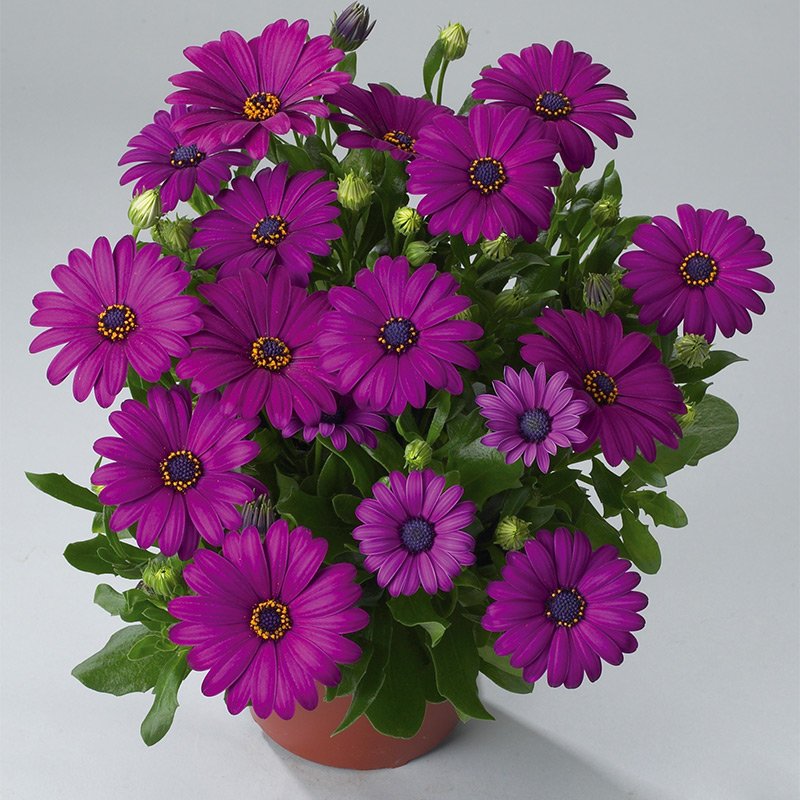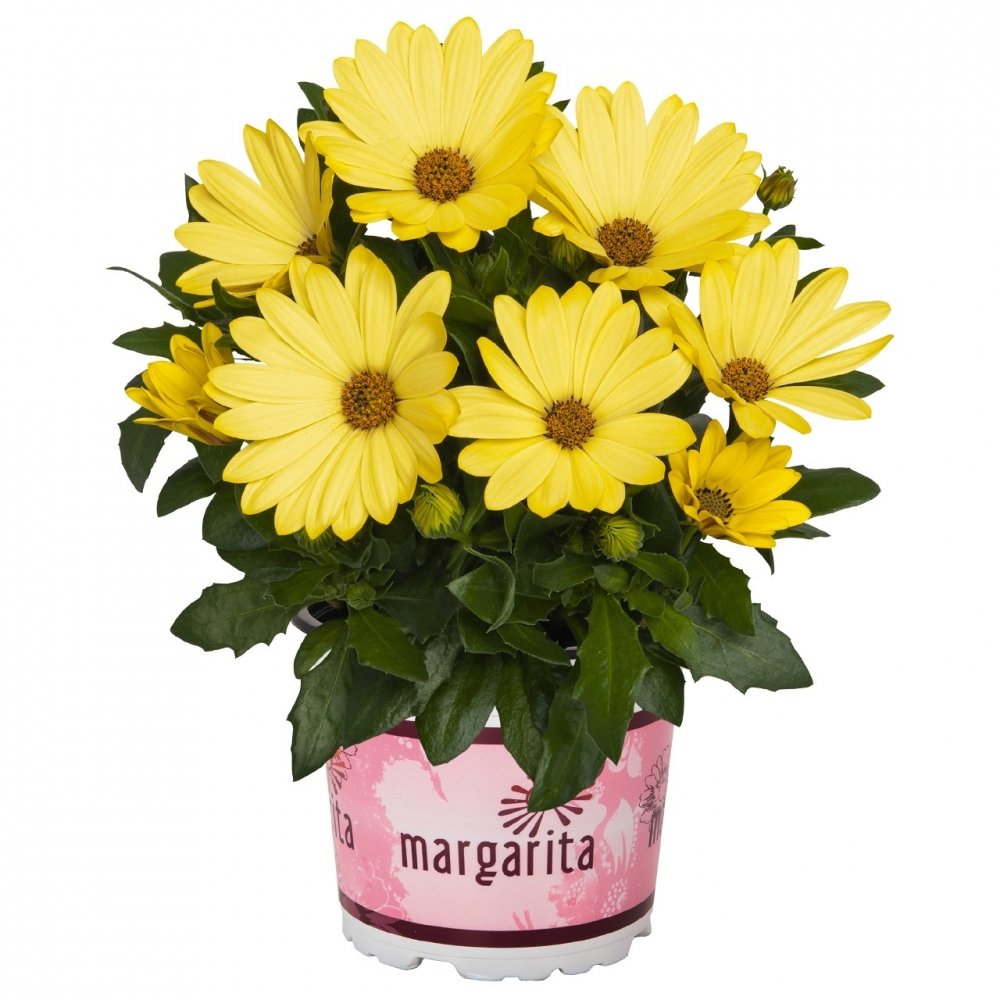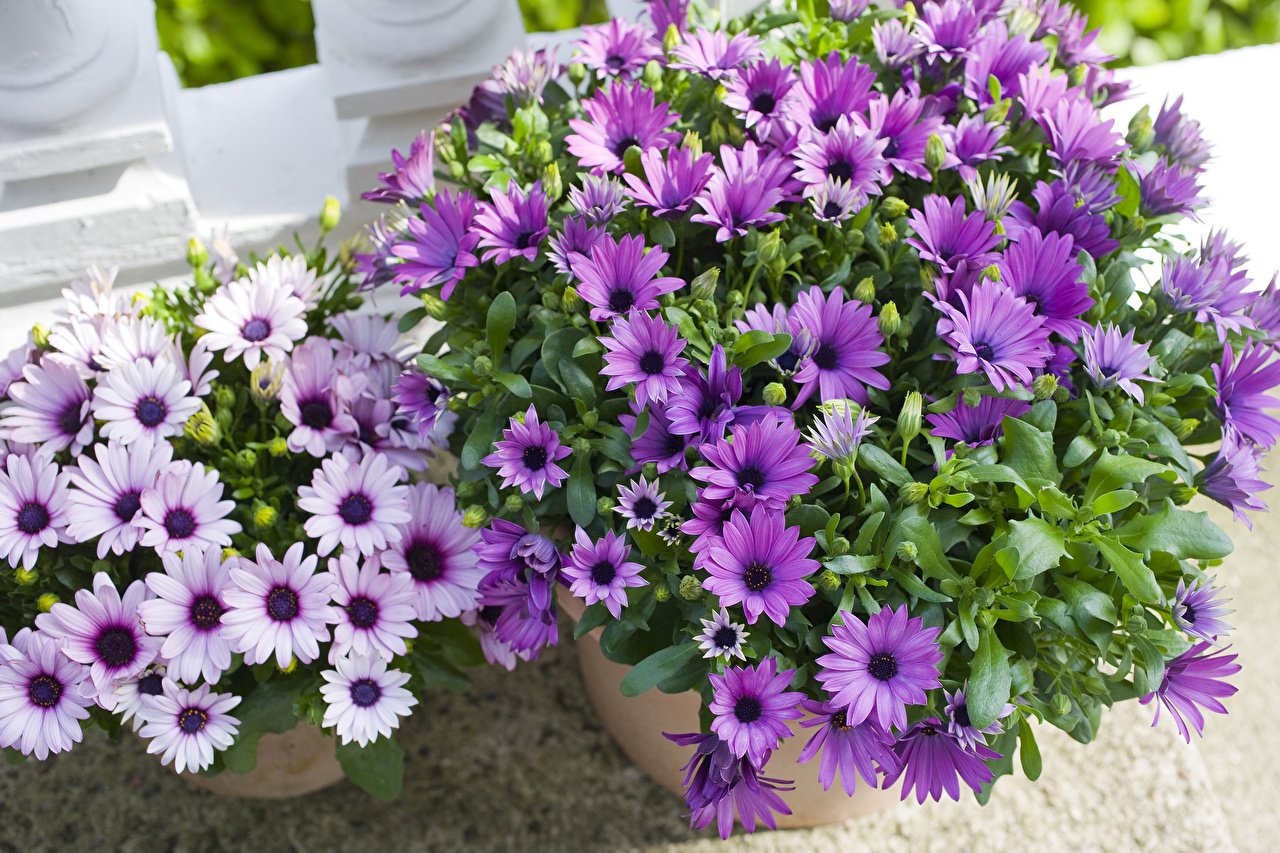The Alluring World of African Daisies
The African Daisy, scientifically known as Osteospermum, is a vibrant and lively addition to any garden. With its daisy-like appearance and a wide array of colors, it captivates not only seasoned gardeners but also those who are just beginning their horticultural journey.
| Osteospermum | Details |
|---|---|
| Plant Type | Perennial, often grown as an annual |
| Mature Size | 1-2 feet tall and wide |
| Sun Exposure | Full sun |
| Soil Type | Well-draining, loamy |
| Soil pH | Neutral to slightly acidic |
| Bloom Time | Spring to fall |
| Flower Color | White, pink, purple, blue, yellow |
| Hardiness Zones | 9-11 (USDA); often grown as annual in cooler zones |
| Temperatures | Prefers cooler temperatures (below 80°F/27°C) |
| Watering | Regular watering but drought tolerant once established |
| Native Area | Southern Africa |
| Toxicity | Non-toxic to humans and pets |

Origins and Botanical Aspects
The African Daisy, or Osteospermum, is native to the rocky slopes and sandy plains of South Africa. Belonging to the Asteraceae family, it shares kinship with daisies, sunflowers, and chrysanthemums. These enchanting flowers have captivated gardeners worldwide with their star-shaped flowers and rich color palettes ranging from white and cream to deep purple and pink.
Morphology: A Rainbow of Petals
Each African Daisy plant proudly displays a unique color spectrum. The flower’s structure is quintessentially daisy-like: a vibrant central disc surrounded by slender petals. The foliage varies from deep green to gray-green and has a slightly fleshy texture, indicative of its tolerance to dry conditions.
Diverse Nicknames Reflecting Beauty
This plant’s charm and versatility are evident in its variety of nicknames. Known as the ‘Blue Eyed Beauty’ for its striking blue center, or more simply as ‘Osteo,’ the African Daisy adapts to different environments while still maintaining its stunning appearance.
A Perennial Favorite with Annual Tendencies
While technically perennials in their native habitat, African Daisies are often treated as annuals in colder climates. They bloom profusely from spring until fall, offering a long season of color and beauty. Their ability to thrive in challenging conditions makes them a valuable asset to any garden or landscape.
Adaptable and Resilient
Osteospermums are notably adaptable, and capable of growing in a range of soil types, though they prefer well-draining, loamy soil. They are drought-tolerant once established, making them an excellent choice for water-wise gardens and xeriscaping. Their resilience to varying conditions underscores their appeal as a low-maintenance but high-impact plant.
Pollinator-Friendly and Environmentally Beneficial
These flowers are not just visually appealing but also serve as a magnet for pollinators. Bees and butterflies are regular visitors, making African Daisies a fantastic choice for eco-friendly gardens aiming to support biodiversity.
The Evolution of Osteospermum
Breeding and cultivation efforts have significantly diversified the Osteospermum genus. From bushy varieties perfect for ground covers to taller, cut-flower varieties, the African Daisy has evolved into a plant suitable for a myriad of garden designs and purposes.
Essential Care Tips for Thriving African Daisies
Caring for African Daisies, is an enjoyable and rewarding endeavor for any gardener. These vibrant, sun-loving flowers, often seen adorning gardens with their cheerful hues, are surprisingly easy to care for. Whether you’re a seasoned gardener or a budding green thumb, understanding the specific needs of African Daisies will ensure a garden full of color and life.
Optimal Sunlight for Vibrant Blooms 🌞
African Daisies are sun worshippers, thriving best in full sun conditions. The key to their profuse blooming lies in the amount of sunlight they receive.
- Sunlight Needs: Aim to provide at least 6 to 8 hours of direct sunlight daily. This exposure is crucial for the development of the rich, vivid colors African Daisies are known for.
- Shade Tolerance: While they can tolerate partial shade, too much shade can lead to leggy growth and fewer blooms. Ensure they get ample sunlight, especially in the cooler months.
- Sunlight and Color Vibrancy: The intensity of the flower colors can be directly linked to sunlight exposure. More sun typically results in brighter, more vibrant blooms.
Watering: Balancing Moisture and Drainage 💧
Watering correctly is essential in the care of Osteospermum, as they prefer a balance between moisture and good drainage.
- Watering Schedule: Water your African Daisies when the top inch of soil feels dry to the touch. This usually means watering once a week, but adjust based on rainfall and temperature.
- Overwatering: Be cautious of overwatering. African Daisies do not like to sit in waterlogged soil, as this can lead to root rot.
- Watering Technique: Water at the base of the plant to avoid wetting the foliage, which can lead to fungal diseases.
Soil Requirements for Healthy Growth 🌱
The right soil can make a significant difference in the health and blooming of your African Daisies.
- Soil Type: Osteospermum prefers well-draining soil. They thrive in loamy or sandy soil that retains enough moisture without becoming soggy.
- Soil pH: These daisies are adaptable to a range of pH levels but generally prefer slightly acidic to neutral soil (pH 6.0 to 7.0).
- Improving Soil Quality: If your soil is heavy or clayey, amend it with organic matter like compost or peat moss to improve drainage.
Fertilization: Providing Nutritional Support 🌼
While African Daisies are not heavy feeders, they do benefit from occasional fertilization.
- Fertilizer Type: Use a balanced, slow-release fertilizer formulated for flowering plants. An NPK ratio of 10-10-10 or similar is ideal.
- Fertilization Schedule: Fertilize in early spring as the plants start growing, and again midway through the blooming season to encourage continuous blooms.
- Avoid Over-fertilization: Too much fertilizer can lead to lush foliage at the expense of flowers. Follow the recommended rates on the fertilizer package.
Pruning and Deadheading for Lush Growth ✂️
Regular pruning and deadheading of Osteospermum not only maintain a neat appearance but also encourage more blooms.
- Deadheading: Remove spent blooms regularly. This practice encourages the plant to produce more flowers rather than setting seeds.
- Pruning: Light pruning in the early spring can help maintain shape and promote bushier growth.
- Winter Pruning: In regions where African Daisies are perennial, cut them back in late autumn or early winter to prepare for the next blooming season.
Pest and Disease Management 🐛
African Daisies are relatively hardy but can occasionally face pest and disease issues.
- Common Pests: Watch out for aphids, spider mites, and whiteflies. These can be managed with insecticidal soap or neem oil.
- Disease Prevention: Good air circulation and proper watering techniques are crucial in preventing fungal diseases like powdery mildew.
- Regular Inspection: Regularly inspect your plants for signs of stress or infestation, which can be key to early intervention and treatment.
Winter Care in Cooler Climates ❄️
In areas where African Daisies are grown as annuals due to cold winters, a few additional steps can help:
- Mulching: Apply a layer of mulch around the base to protect the roots from freezing temperatures.
- Container Plants: If grown in containers, move them indoors or to a sheltered area to protect them from frost.

How to Grow African Daisy (Osteospermum) Successfully
Starting African Daisies from Seeds 🌼
The journey of growing African Daisies often begins with seeds. These plants can be easily grown from seeds, either sown directly in the garden or started indoors.
- Seed Sowing Time: For outdoor planting, sow the seeds after the last frost when the soil has warmed up. If starting indoors, begin 6-8 weeks before the last expected frost date.
- Soil Preparation: Use a well-draining soil mix, ideally with a pH between 6.0 and 7.5. Ensure the soil is moist but not waterlogged.
- Sowing Depth: Sprinkle the seeds on the soil surface and lightly cover them with a thin layer of soil or vermiculite. African Daisy seeds need some light to germinate, so don’t bury them too deep.
- Germination Environment: Keep the soil consistently moist and place in a warm, bright location. Germination typically occurs within 2-3 weeks.
- Transplanting Seedlings: Once the seedlings have a couple of true leaves and are sturdy enough, transplant them to their final location, spacing them about 8-12 inches apart.
Planting African Daisies in the Garden 🏡
African Daisies make for a stunning display in garden beds and borders. Here’s how to ensure they thrive outdoors:
- Choosing the Right Spot: Select a location that receives full sun for most of the day. These flowers flourish in bright sunlight, which intensifies their bloom colors.
- Soil Requirements: Plant them in well-draining soil. While they are adaptable to various soil types, poor drainage can lead to root issues.
- Watering Regime: Water the plants regularly while they are established. Once established, African Daisies are drought-tolerant, so you can reduce the watering frequency.
- Fertilizing: Apply a balanced, slow-release fertilizer at the beginning of the growing season to support healthy growth and flowering.
Growing African Daisies in Containers 🌺
African Daisies are excellent for container gardening, adding a burst of color to patios, balconies, and indoor spaces.
- Container Selection: Choose a container with good drainage holes. Ensure it is large enough to accommodate the root growth.
- Soil for Containers: Use a high-quality potting mix that ensures good drainage.
- Watering in Containers: Container plants may require more frequent watering. Check the soil moisture regularly and water when the top inch of soil feels dry.
- Fertilizer for Container Plants: Feed container-grown African Daisies every four to six weeks with a water-soluble fertilizer.
Indoor Cultivation of African Daisies 🏠
Growing African Daisies indoors can bring a cheerful ambiance to your living space. Here’s how to ensure they thrive inside:
- Bright Light: Place the plant in a spot where it can receive plenty of bright, indirect sunlight. A south-facing window is ideal.
- Temperature and Humidity: Keep the room at a moderate temperature, avoiding cold drafts. African Daisies prefer average room humidity.
- Potting and Repotting: Use a well-draining potting mix and repot when the plant outgrows its current pot.
- Regular Care: Water the plant when the soil dries out and deadhead regularly to encourage more blooms. Rotate the pot occasionally for even growth.
By understanding these essential aspects of growing African Daisies, you can ensure these blooms are a feature in your garden or home. Their adaptability, coupled with their dazzling appearance, makes Osteospermum a rewarding choice for plant lovers alike. With the right care, you’ll be rewarded with a bounty of colorful blooms.

FAQ Osteospermum (African Daisies)
Are African Daisies, also known as Osteospermum, perennials?
Yes and no. While Osteospermum, commonly known as Cape Daisy, are perennials in their native South African climate, they are often grown as annual plants in colder regions. In areas where frost is a concern, they may not survive the winter unless brought indoors or provided with adequate protection.
Are Osteospermum plants poisonous to dogs and cats?
Fortunately, Osteospermum is not known to be toxic to dogs and cats. These beautiful flowers can be a safe choice for pet owners looking to brighten up their gardens with daisy-like flowers.
How long does Osteospermum bloom?
Osteospermum plants, with their vibrant array of flower buds, typically bloom throughout the growing season. You can expect these stunning flowers to grace your garden with color from late spring through late summer, sometimes even until the first frost.
Does Osteospermum come back every year?
Whether Osteospermum will return each year depends on your climate. In warmer areas where frost is not a concern, these plants can grow perennially. However, in colder climates, they are often treated as annuals unless you take steps to overwinter them.
Do Osteospermum like full sun?
Absolutely! Osteospermum, or Blue-Eyed Daisy, thrives in full sun. They prefer to bask in sunlight for at least six hours a day. This sun exposure is crucial for the plant to grow and bloom optimally, producing its signature daisy-like flowers with a purple center.
Is the African Daisy a good indoor plant?
While typically grown outdoors, African Daisy varieties can be cultivated as indoor plants, provided they receive adequate sunlight. Place them near a window where they can enjoy plenty of light. Remember, these plants prefer sun to shade and will reward you with their orange, pink, and purple flowers when their light needs are met.
When should I cut back Osteospermum?
Pruning African Daisies is best done in late summer or early fall after the peak blooming period has passed. Cutting back spent flowers and shaping the plant can encourage new growth and blooms. For perennial varieties, a more thorough pruning may be done in late autumn to prepare the plants for winter.
Does Osteospermum reseed themselves?
While some species of Osteospermum can self-seed, it’s not a guarantee. If you want to propagate new plants, it’s better to collect seeds directly or grow new plants from cuttings. This way, you can ensure the young plants have the desired characteristics of the parent plant.
Are African Daisies deer resistant?
Yes, African Daisies are largely deer-resistant. Their foliage and flowers are not typically favored by deer, making them a good choice for gardens in areas where deer are common. However, in times of scarcity, deer might nibble on anything green, including these lovely daisies.
Incorporating Osteospermum, or African Daisies, in your garden can create a spectacular display of color and beauty. Whether you are planting your African Daisies in combination with other plants, propagating African Daisies for more blooms, or simply enjoying their flowers that stay open throughout the day, these plants are a delightful addition to any garden or as indoor plants. Remember, these species of Osteospermum, with their diverse colors like orange and pink flowers, are not just aesthetically pleasing but also resilient and easy to care for. 🌸🌱
Megan Stewart, a houseplant aficionado and biologist, resides in the city of Portland, Oregon, USA. Her passion for greenery is matched only by her academic prowess; Megan holds a degree in Biology from the University of Oregon. This background has provided her with a rich understanding of the biological intricacies of plant life, which she skillfully applies to her collection of indoor plants.
Megan's home is a testament to her love for all things green, filled with a diverse array of houseplants ranging from exotic orchids to robust succulents. When she's not tending to her indoor garden, she spends her time with her beloved pets, a constant source of companionship and joy. Her articles are a reflection of her life's passions, offering readers a blend of practical plant care advice, and insightful biological tidbits.
Through her writing, Megan aims to inspire others in the USA and beyond to create their urban jungles and foster a deeper connection with nature.


